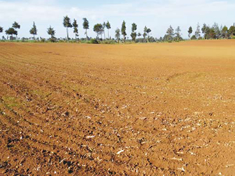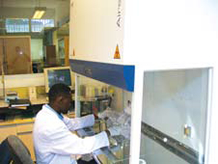Reasons for Farmers to Test their Soil
 Farmers will know the current condition of their soil and how to improve it
Farmers will know the current condition of their soil and how to improve it
Soil fertility is determined by the soil’s chemical, physical and biological properties. Properties such as soil texture, color and structure are visible to the eye. However you can’t see the chemical composition of soil. Therefore it needs to be measured. That is why soil sampling is essential.
Soil tests are used to determine the soil’s nutrient content and pH level. With this information you can define the exact type and quantity of fertiliser needed to be applied to improve your soil. This is important because fertile soils are necessary to grow healthy crops. Soil testing before applying fertilisers is recommended in order to determine the soils status and nutrient need. Only then you know the exact type and quantity of fertiliser you need to use. If you apply fertiliser without knowing what your soil needs, you risk using too little fertiliser (under-fertilisation) and not achieving optimal yield. If you apply too much fertiliser (over-fertilisation) or apply it at the wrong time, there is a chance of “fertiliser burn” - scorching of plant foliage as a result of excess.
Farmers can minimise fertiliser expenditure
Knowing the exact type and quantity of fertilisers your soil and crops need prevents you from wasting money on unnecessary fertilisers. Moreover, nutrients such as phosphorus and potassium that are part of inorganic fertilisers are limited resources. Their supply is finite thus we need to be cautious in our usage to prevent future shortage of inorganic fertilisers.
That is simply a waste of money. The excessive fertiliser will not improve your yield and might have a negative effect on the environment.
With soil testing farmers can avoid over fertilisation
Applying fertiliser without knowing the actual nutrient needs of your soil might lead to overfertilisation. Testing your soil and receiving a fertiliser recommendation prevents applying excessive amount of fertilisers and the related environmental damages. Over-fertilisation might result in nutrient leaching, water pollution and irreversible harm to the aquatic animal life. A simple soil test can prevent this negative effect. Furthermore, overuse of fertiliser is harmful not only to the environment but also to the crops as it might cause fertiliser burn.
Farmers can avoid soil degradation
It is estimated that each year 24 billion tonnes of fertile soil are lost due to erosion which is a result of unbalanced soil management. Moreover, land degradation directly impacts the health and livelihoods of an estimated 1.5 billion people. Soil restoration is a difficult, costly and time-consuming process. Therefore, proper soil management in the form of soil testing and application of the right fertilisers is more efficient and financially justified.
Farmers with fertile soils can contribute to feeding the world’s growing population
Nowadays we put more pressure on our soil than ever before. We need fertile soils to feed the world’s rapidly growing population. Improved soil fertility means more crops worldwide, potentially closing the world’s food gap. This will bring a better life for millions of people particularly in developing countries.Soil testing is the first step in soil fertility management. Soil testing gives valuable information and helps you improve your soil’s health. And healthy soils mean healthy crops!
 Test your Soil Before Buying Fertilizer
Test your Soil Before Buying Fertilizer
Did you know that global fertiliser use is expected to surpass 200 million tonnes in 2018? Fertilisers are increasingly popular because they successfully support plant growth and increase the yield. But what are the dangers of overusing fertilisers? Did you know that too much fertilisation might cause “fertiliser burn”? There are more the negative effects of using fertiliser without knowing your soil’s nutrient needs.
Wasting limited resources
Nutrients such as phosphorus and potassium present in inorganic fertilisers are limited resources. Phosphorus for example is mined from phosphate deposits that are unevenly distributed around the world. The term “peak phosphorus” is used to describe the point in time when we reach the maximum global production rate of phosphorus. According to researchers peak phosphorus will be reached in approximately 2030, whereas phosphorus reserves are expected to be depleted within the next 100 years. Therefore, we need to be more efficient in our usage of phosphorbased fertilisers nowadays in order to prevent shortage in the future.
Causing environmental damage due to over-fertilising
Soil testing provides a fertiliser recommendation and enables farmers to apply the right fertiliser and quantity that will be utilised by the plants. This minimises the chances of applying excessive amounts of fertilisers and the resulting environmental damage. For example, excessive nitrogen-rich fertilisers might runoff from the field into water bodies causing excess of nutrients in the water and a rapid growth of plant life – a process known as eutrophication – with detrimental effects for water quality.
What can farmers do to prevent this?
The popularity of fertilisers is increasing due to the need to feed the world’s growing population; however the dangers of overusing them are often overlooked. Agronomists need to promote responsible fertiliser use and sustainable soil management. As discussed above, testing your soil and getting to know its nutrient needs before applying any fertilisation is the best way to avoid over-fertilising your soil and wasting your money on unnecessary soil enrichers.
How fertiliser recommendations are made Dr. Christy van Beek, senior soil scientist at Soil Cares and expert in soil fertility, shares what 20 years of experience has taught her about fertiliser recommendations.
So many roads to Rome
Back to the techniques of making a fertiliser recommendation. Again, there are some decisions to make, starting with the fundamental approach of the recommendation. This is followed by the input parameters used and the way they are derived.
Fertiliser recommendations basically serve to restore or maintain the productive capacity of the soil. Therefore, they commonly consider the soil status and the amount of nutrients withdrawn by crops.
To do so, one can use one of the following methods:
Balance method
Apply as much as is withdrawn from the system taking into account managed (e.g. harvest) and un-managed (e.g. erosion) losses. This method is sound and clear, but assumes that the soil is currently in good condition. If this is not the case, this approach will ‘recycle poverty’.
Threshold method
When the content of a certain element in soil is below a specific threshold; it is applied to the level in which it is not insufficient anymore. This method is widely used, but the correct determination of the threshold is difficult, nor does it consider interactions between nutrients.
Trial and error
Different combinations of fertilisers are applied and one looks at the highest yield response. Although this is not very scientific; the approach is often used.
Yield response method
This method is based on field experiments in which a relationship is determined between the amount of fertilisers and the yields obtained per crop. Apart from the costs of doing extensive field trials, the method is also only valid within the area of the experiment.
Simulation modelling
Empirical, semi empirical and physiological relations are used to calculate the exact fertiliser requirement. This method is actually only applicable for scientists and requires substantial amounts of data.
Combination of different techniques
Often, the methods above are combined. For example, a threshold is corrected with a balance method, or the yield response curve is used for simulation modelling. Many examples of the above methods can be found in Ethiopia, which is currently reviewing its fertiliser policy. Notwithstanding the method, all except the balance method require soil data.
Soil data can be obtained from wet chemistry laboratories or from ‘dry chemistry’, which uses spectrometers like the technology developed at Soil Cares.